This Overlooked Region of France Has Charming Bistros, Historic Towns, and Top-notch Museums — and None of the Crowds
- Oops!Something went wrong.Please try again later.
Limousin, France, is an utterly enchanting side of France that tourists rarely see.
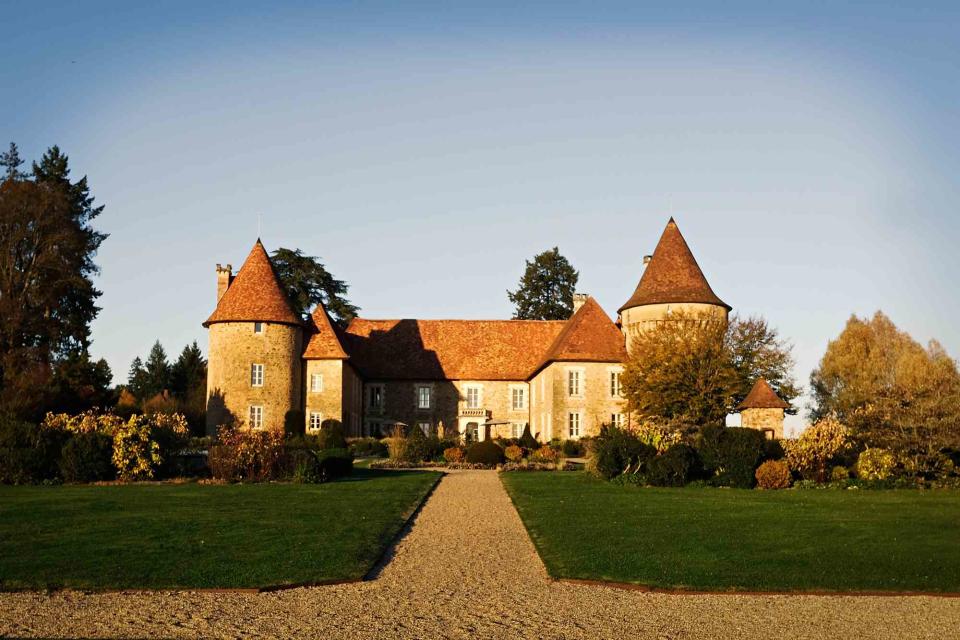
William Craig Moyes
Domaine des Étangs, a 13th-century château set on 2,500 acres in Massignac—now part of Auberge Resorts Collection.I arrived in Limousin in a rental car, which felt wrong: it should surely have been a stretch limo. There are several theories as to how a motorized symbol of wealth and luxury came to be named for a rural part of central France that, while beautiful, is almost entirely devoid of opulence, but none are particularly convincing. One theory is that the limousine was christened in honor of native son Charles Jeantaud, the late-19th-century inventor of an early form of the motorcar. The other is that the hood of the early limo, intended to protect the chauffeur, resembled the hooded cloaks of Limousin shepherds. Whatever the truth, it’s amusing to think that what was once the preferred mode of transportation for celebrities and royalty is named for a region best known for crockery and cows.
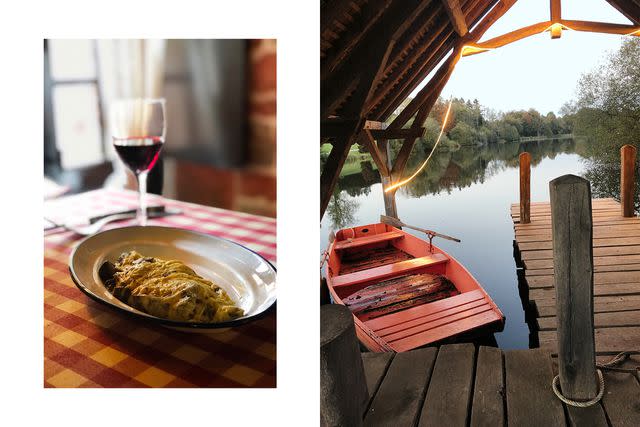
William Craig Moyes
From left: A mushroom omelette at Le Cantou, in Collonges-la-Rouge; a rowboat at Domaine des Étangs.I got an inkling that there was more to Limousin than exquisite porcelain and delicious meat (Limousin veal is famous throughout France) a couple of years ago. During a cross-country trip, I made a brief stop in Limoges, the region’s capital. Having read about the glorious train station, I ducked in. It was amazing: a palace in pale stone, with a giant dome decorated with stained glass by Limousin’s master glass craftsman, Francis Chigot. Beneath that grand cupola loomed a quartet of sculpted women, each embodying a region of France. The figure of Le Limousin held a vase representing Limoges’ famous porcelain in one hand and reached toward a canopy of wheat and chestnuts with the other. I’ve seen many provincial French train stations, and they don’t normally look like this. As I marveled at the spectacular setting, I sensed there was much more to this region than I had once thought.
Related: The Best Times to Visit Paris
I was hardly alone in underestimating Limousin. In fact, since World War I, when a bunch of ineffective army top brass were relieved of their posts and sent to Limoges, someone who has been laid off or fired is referred to in French as limogé. But places overlooked in the capital tend to preserve their unique charms better than those inundated by fashionable Parisians. And adding to the fascination of my stone Limousin lady was the fact that she is a ghost: the region is officially extinct, annulled in 2016 at the whim of French bureaucracy, joining two other regions to become the administrative area of Nouvelle-Aquitaine.
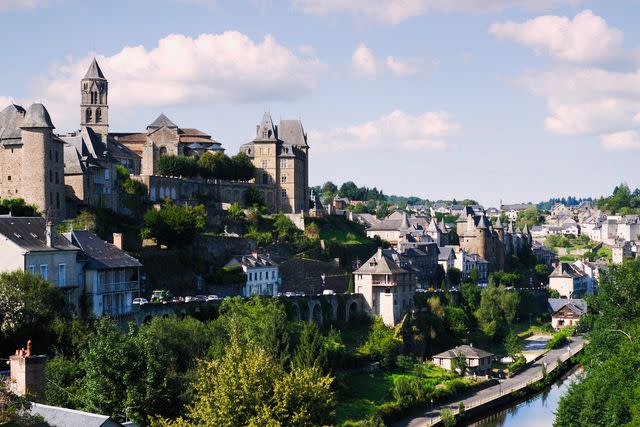
William Craig Moyes
The medieval town of Uzerche.So, with no limousine but my husband, Craig, as chauffeur and photographer, I went to explore. I found an unkempt wilderness so beautiful that, I learned, 19th-century painters risked highway robbery to visit. I discovered an ancient abbey with a history of heroism, lively food markets, and excellent bistros and fine-dining restaurants, thanks to local produce that goes far beyond Limousin veal.
We arrived at Domaine des Étangs via Angoulême, a city of gray-white stone that looks so exactly as a French city should that it served as the town of Ennui-sur-Blasé in Wes Anderson’s 2021 film "The French Dispatch." The Domaine, a 13th-century château surrounded by rich pasture, was decorated by the designer Isabelle Stanislas, who recently updated some of the rooms in the Élysée Palace. The hotel, which has been owned by the Primat family (who made their fortune in oil) since the 1980s, became the first French property in the Auberge Resorts Collection in April.
Related: Travel + Leisure Readers' 5 Favorite Resorts in France of 2023
The 2,500-acre estate is dotted with ponds (the eponymous étangs), and there are rowboats available for guests to use. The spa is in a beautifully refurbished water mill with indoor and outdoor pools and a series of thermal baths. Even the lakeside tennis court seemed to float, which looked lovely but had one major drawback: after one too many balls sank without a trace, Craig and I set off to explore, starting with the gallery in the converted dairy. Owner Garance Primat is a true devotee of art, and there are sculptures everywhere on the grounds, including Vénus de l’Étang, which Chinese artist Wang Keping carved from a 100-year-old red oak, and Ugo Rondinone’s eerie Sun, made from tree branches cast in bronze.
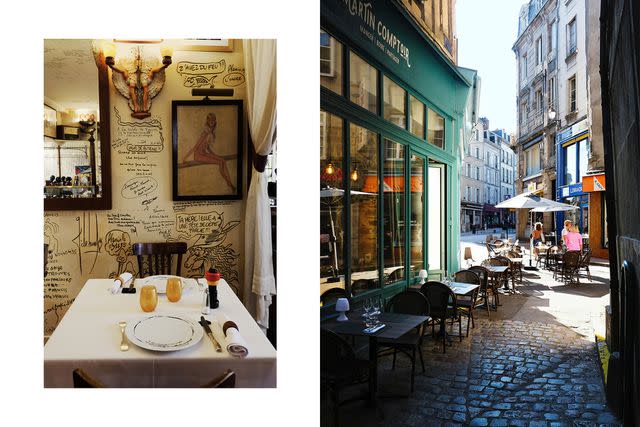
William Craig Moyes
From left: Cartoons at Chez Francis, in Brive; a cobblestoned street in Limoges.We roamed the château, walking through the vast game room under the eaves and elegant salons where guests can noodle on grand pianos. The main building’s seven guest rooms and suites were decorated in neutral colors that quietly showcased limestone walls and large fireplaces. The restaurant, where the menu featured a long list of local suppliers, served Limousin veal so tender I barely needed a knife.
The next day we drove out into the velvet-green hills, watched warily by a herd of Limousin cows — 600 of them, according to general manager Vincenzo Iaconis. “I’m going to become vegetarian,” he said, laughing. “They’re outside my house, and they’re too beautiful to eat.” Iaconis showed us around one of six cottages that have been repurposed as guesthouses, their stone walls and wooden beams softened by deep sofas and freestanding baths. A few have fireplaces big enough for an in-house chef to cook a spit-roast, if a guest should ask.
"I arrived in Limousin in a rental car, which felt wrong: it should surely have been a stretch limo. There are several theories as to how a motorized symbol of wealth and luxury came to be named for a rural part of central France that, while beautiful, is almost entirely devoid of opulence."
The drive to Brive-la-Gaillarde took us through the wooded Périgord Limousin Regional Natural Park, after which we made a brief photo stop at Uzerche, a village so postcard-perfect it was nicknamed “Pearl of the Limousin” in the 18th century. Brive is best known today for a saucy song by the French singer Georges Brassens, recorded in 1952, about a fight breaking out between female shoppers and the police in the food market. The market, now named in Brassens’ honor, still had the earthiness he described, but the market-goers, thankfully, were today more chatty than confrontational. Tables teemed with cheeses, dripping honeycombs, and the biggest cabbages I’ve ever seen. I found bread by the kilo, plump prunes, and the season’s first mushrooms.
A market this good acts like a siren, luring back local chefs who went to Paris to make their names. Nicolas Eche, originally from a village south of Brive, is one: his lively En Cuisine restaurant serves ambitious dishes, including prawns with cauliflower sauce and a veal trilogy: filet, head, and crispy sweetbreads.
More Trip Ideas: The South of France Is My Favorite Vacation Destination — Here Are Its 20 Best Places to Visit
Perhaps the most charming of Brive’s restaurants is Chez Francis, not because of the food — although Francis Teyssandier serves a delicious terrine and an airy soufflé with raspberries — but thanks to the cheeky hand-drawn cartoons that gambol across the walls. They’re the work of the authors who eat at the restaurantduring Brive’s annual book fair in November.
A 10-minute stroll across town took me to the Denoix distillery, which looked like it hadn’t changed much since it opened for business in 1839. In large copper pots, owner Sylvie Denoix-Vieillefosse stirred the juice of pressed green walnuts, blended with brandy, orange peel, curaçao, fennel, and juniper, which would be aged in oak for five years. “We don’t make alcohol,” she explained. “We are more like parfumiers, using alcohol to extract the flavor of plants.”
There are two kinds of beauty in Limousin. One is wild and unkempt — what the 19th-century novelist George Sand, who grew up just north in Nohant-Vic, called the “savage and joyous” landscape — the other is manicured to an almost uncanny prettiness. Uzerche fell into the latter category: a cluster of towers and turrets rising steeply from the river Vézère like the layers of a wedding cake. So did Collonges-la-Rouge, a village built almost entirely of the local red sandstone, from its chapel to the bread oven in the marketplace. At Le Cantou, a restaurant in a 15th-century building, we ate an excellent mushroom omelette, served with free cooking tips (“an omelette should only ever be beaten with a fork or the texture won’t be right,” instructed our waitress), then wandered the narrow streets.
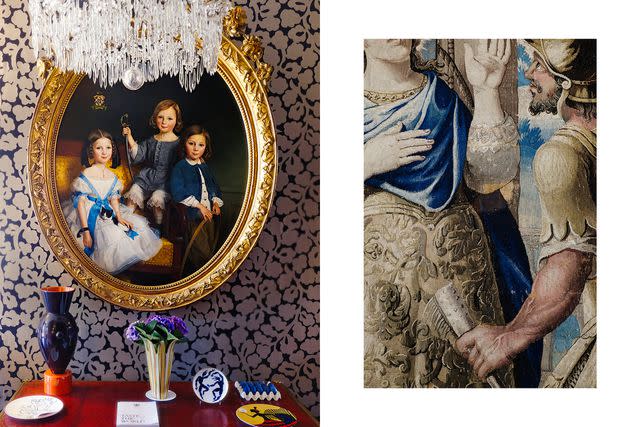
William Craig Moyes
From left: A scene at La Chapelle Saint Martin, an intimate hotel in Nieul; detail of a tapestry in Aubusson.Still, like Sand, I was more enchanted by the wildness. The Monks’ Canal at Aubazine was carved from sheer rock by 12th-century Cistercians, a largely silent order. The walk along it was glorious, the tree-coated vistas of the Dordogne Valley barely disturbed by any evidence of humanity. The canal water fed their vast abbey, which after the French Revolution became a convent and orphanage. Today there is a plaque thanking the nuns who risked their lives to hide Annette and Jeanne, two Jewish girls, from the Nazis. Annette grew up to be the mother of Michel Hazanavicius, the Oscar-winning director of the silent film "The Artist," and I liked the idea of a thread connecting those mute monks to a modern work of art that is deliberately soundless, via a refusal to talk that actually saved lives.
In the abbey, the light filtered through the stained-glass windows, each one a study in elegant restraint. Their interlocking circles looked familiar, but it was only when the guide began to talk about another resident of the orphanage that I realized why: Gabrielle “Coco” Chanel’s famous logo may have been inspired by the windows of her poverty-stricken childhood.
The town of Aubusson has been famous for its tapestries for 600 years, and its museum, the Cité Internationale de la Tapisserie, houses a magnificent collection. I walked through the ages, from a 16th-century depiction of sharp-toothed beasts feasting on placid prey amid swirling greenery to works by modern painters, including Alexander Calder, Pablo Picasso, and Georges Braque, whose "Tête Noire," an eerily beautiful woman’s head, was one of my favorites. In another room, I watched two craftspeople weaving a scene from Hayao Miyazaki’s film "Princess Mononoke." This vast piece, "Ashitaka Soothes His Demonic Wound," would take them a year to complete.
"There are two kinds of beauty in Limousin. One is wild and unkempt; the other is manicured to an almost uncanny prettiness."
I thought I had spotted another tapestry above our bed in La Creuzette, a perfectly proportioned mansion in the village of Boussac that South African transplants Hardy Olivier and Louis Jansen van Vuuren renovated 20 years ago. Actually, on closer inspection, the young man with the artfully placed draperies was painted: Olivier explained it was a 19th-century cartoon, one of the designs from which tapestries are copied, that he had had restored. The couple, who sold the property to an investor but still run the day-to-day operations, were ideal hosts: when we felt sociable, they poured champagne and told anecdotes about acquiring the mansion, including the discovery, once they’d bought it, of a tree growing in one room. When we didn’t, Olivier delivered wine to our room, then vanished. An accomplished chef, he can also whip up fabulous dinners; van Vuuren, an artist, leads painting retreats.
Boussac seemed an unlikely home for such sophisticates, but they aren’t the first urbanites to fall for this hilltop village. George Sand used to stay in the nearby Château de Boussac, where she discovered the medieval "Lady and the Unicorn" tapestries that now live in the Cluny Museum in Paris. She introduced the tapestries to her lover Prosper Mérimée, the author of the novella Carmen who also happened to be France’s inspector general of historical monuments, which led to their rescue.
However, Sand, born Aurore Dupin, was still more influential in the village of Crozant, an hour’s drive west. She went there with various lovers and the evocative descriptions in her 1845 novel, "The Sin of Monsieur Antoine," would lure artists including Francis Picabia and Claude Monet.
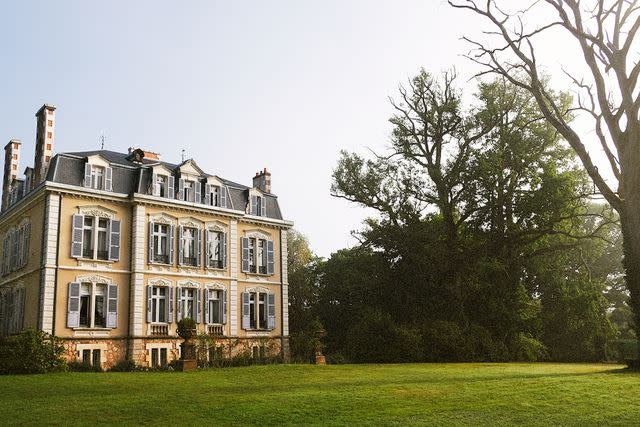
William Craig Moyes
La Creuzette, a restored mansion turned guesthouse in the village of Boussac.“Everything here inflames the imagination…everything grips the heart,” she wrote, and certainly my first glimpse of the spectacular medieval fortress, its smooth rectangular walls crumbled so that a spike jutted against the autumn sky, took my breath away. No wonder painters were prepared to brave a journey that, before trains, took a week.
Our journey to Limoges was far less arduous. We stopped outside of town and checked in to La Chapelle Saint Martin, a small Relais & Châteaux hotel owned by chef Gilles Dudognon, whose restaurant has a Michelin star. Out front was the chapel, which wasn’t a chapel at all but a peculiar A-frame structure that looked like a larger version of the beehives that are scattered across the grounds. At Dudognon’s restaurant, we dined on the sweetest green beans from the hotel garden, topped with truffle slices and orange flowers, and Limousin veal with local girolles. It was all served on Limoges porcelain so delicate that much of it requires hand-washing.
Visiting Oradour-sur-Glane required only a quick detour, and it felt important: I knew it was where we would find some of the most tragic ghosts in this phantom province. On a single day In 1944, the Nazis murdered 642 unarmed villagers, including women and children, before torching the town. Every bit of the ruins was deliberately preserved: signs outside defunct cafés, rust-brown car carcasses, an altar in the roofless church. To this day, nobody knows why this particular village was chosen for such a savage attack. It was easy, though, wandering the grassed-over streets and looking up at the sky through empty windows, to imagine the place full of life. It made for a powerful memorial.
After so much destruction we found relief in beauty. Limoges was already known for its painted enamels when a deposit of the special kaolin clay needed to make fine porcelain was discovered in the 18th century. But there is more to the town than its most famous product, as the grand train station had hinted. There are enamels and Impressionist paintings in the Limoges Museum of Fine Arts (Auguste Renoir was born here), a great covered market, and narrow lanes full of half-timbered medieval houses. At one of them, Les Petits Ventres, a cozy, beamed bistro, we ate flaky pastry topped with black pudding and Limousin apples. Nearby cheese maker Jean-Marie Dufour led us down to the 10th-century cellar where he ages his cheeses, patting them down by hand or brush to prevent rot.
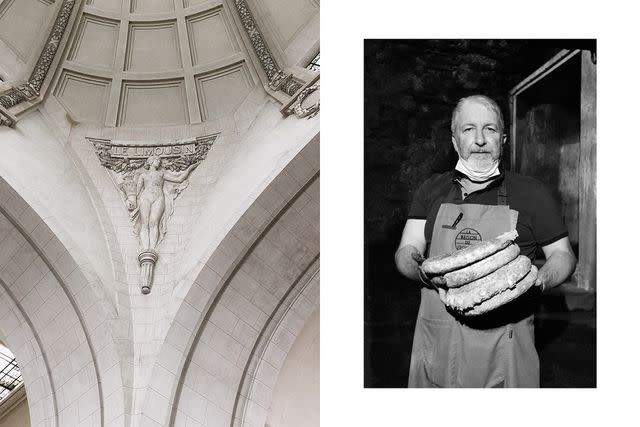
William Craig Moyes
From left: A carving of a woman representing the Limousin region in the Limoges train station; cheese maker Jean-Marie Dufour in Limoges.Then we went to see the porcelain. I was expecting nice tableware, but the Adrien Dubouché National Museum has floors filled with precious pieces celebrating not just Limoges but the material’s whole long and varied history, from terra-cotta vessels made in Greece in the ninth century B.C. to delicate Chinese pieces to exquisite coffee services and artworks by Cindy Sherman and Picasso. I lusted after a giant porcelain chess set, while Craig eyed a 19th-century teacup with a special inset on which to rest a mustache.
It felt entirely right that a material I had considered purely decorative turned out to have far more to offer. I had gone to Limousin looking for pretty plates and great produce, but the region had also offered me churches and tapestries, stunning landscapes and high art. Coming here, I reflected, was the opposite of being limogé. Before boarding my train, I looked up at that carved Limousin lady, who held what seemed by that point to be a rather meager armful of local specialties, and smiled an apology for my earlier ignorance. And I could have sworn she smiled back.
Limousin at a Glance
Where to Stay
A 2,500-acre resort dotted with cows, lakes, and works of art. There is a floating tennis court and a spa in a converted water mill. Doubles from $450.
This small hotel in Nieul has a fine-dining restaurant, a bistro, and lakeside dining “hives.” The outdoor pool is an ideal spot to pass the time between meals. Doubles from $273.
This once-dilapidated mansion in the village of Boussac is today an idyllic five-bedroom lodging where every textile and furnishing has been chosen with loving care. Doubles from $185.
Where to Eat
Hand-drawn cartoons, courtesy of the writers who come to Brive-la-Gaillarde for the annual book fair, serve as a whimsical backdrop for chef Francis Teyssandier’s market- fresh dishes, like grilled duck with fennel. Entrées $32$43.
The atmosphere at this cozy spot in Brive-la-Gaillarde may be relaxed, but the food is ambitious: think amuse-bouches like foie gras with truffle gelée and celery, but no white tablecloths. Prix fixe from $29.
The Valen family has owned this building in Collonges-la-Rouge for generations. Part of it is now a restaurant that serves hearty dishes like calf’s head, country pâté, and rump steak. Prix fixe from $24.
In Limoges, this lovely restaurant with beams and open fires is a carnivore’s delight offering everything from offal to steak. Entrées $21$31.
What to Do
Adrien Dubouché National Museum
The museum houses pottery from antiquity to the present day, including the largest collection of Limoges porcelain in the world.
Founded in the 12th century by a young priest whose beautifully carved tomb is still in situ, the complex features a unique bell tower and rare stained- glass windows.
Cité Internationale de la Tapisserie, Aubusson
The museum’s collection spans six centuries, with pieces ranging from a 1480 tapestry of a unicorn to works by modern masters.
The Denoix family has been making walnut liqueurs in Brive-la-Gaillarde since 1839 and not much has changed: waist-high vats are still stirred with copper ladles. The liqueurs, the result of this region’s abundance of nuts, are delicious.
This eclectic collection features antiquities from Egypt, enamel pieces from the Middle Ages, and modern works by the likes of Henri Matisse and Fernand Léger.
Once an inn that accommodated the artists who traveled to “Painters’ Valley,” this museum in Crozant now tells the story of those painters, who range from the famous to the obscure.
During World War II, one of the worst massacres on French soil took place in this village. Though an accompanying museum tells the story in words and pictures, it’s the ruined village itself that’s almost unbearably moving: an ordinary place, made exceptional by cruelty.
A version of this story first appeared in the September 2023 issue of Travel + Leisure under the headline "The French Dispatch."
For more Travel & Leisure news, make sure to sign up for our newsletter!
Read the original article on Travel & Leisure.

